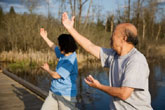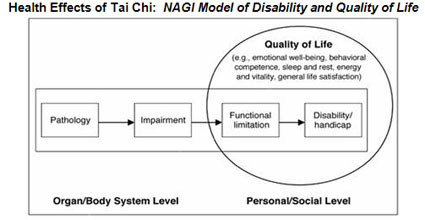
T'ai Chi Ch'uan, or Tai Chi
(pronounced taiji) as it is commonly called, is a slow
graceful exercise developed around the 13th century by
Chinese families, a combination of meditation and martial
arts. It was passed down from generation to generation and
kept secret among the families until the 1800's when it was
taught as an advanced form of martial arts to the Chinese
army and eventually to the public. It has since been
promoted as a health exercise and became widely popular
among adults of all ages. Today Tai Chi is practiced daily,
on street corners, in parks, before going to work. In the
late sixties it began to take root in the United States and
Europe. There are different styles developed by different
Chinese families but the Yang style form remains the most
widely used and taught. T'ai Chi translates as "supreme
ultimate", the center or common source that unifies all
apparent opposites.
Benefits:
Tai Chi can be practiced by people of all ages and most
physical conditions. Regular practice helps develop healthy
breathing patterns and relaxation skills. As a non-impact
exercise it strengthens the body with minimal stress to the
joints. It improves body awareness, postural alignment,
coordination, strength and flexibility. It trains you to
utilize deeper structural muscles which strengthen the
tendons and bones.
Tai Chi is a moderately aerobic exercise that can reduce
stress levels and enhance the body's immune response.
Regular practice lowers blood pressure and promotes
emotional well-being. It is also an ideal weight-bearing
exercise that helps improve balance.
Tai Chi works at multiple levels of the Nagi Model:

FROM: http://books.nap.edu/html/work_disability/ch2.html
(8/22/07)
Addresses Physical Impairments
• Range of motion (AROM, PROM)
• Flexibility
• Strength
• Postural stability (muscular endurance, proprioception)
• Bone density (Weight-bearing exercise)
• CV system: ↑ circulation, ↓BP, ↓ RR
Addresses Functional Limitations
• Balance and coordination
• Gait improvements (↓ risk of falls)
Enhances Mindfulness
• ↓ stress / ↑ relaxation
• Improves overall Quality of Life
Tai Chi teaches you to move with effortless grace, a skill
that can be applied to any activity from running, surfing,
rock climbing, and basketball to walking, lifting objects,
and even playing a musical instrument. This ancient Chinese
"supreme ultimate" exercise has universal applications. Tai Chi offers
health care professionals a new tool to use with their
patients and a personal practice that enhances their
effectiveness as well as their own state of mind. Patients
and clients receive a lifelong practice that improves their
overall quality of life.
Last revised: March 5, 2010
by Tricia Yu, MA, Kristi Hallisy PT, MS, OCS, CMPT, CTI,
Patricia Culotti, BSA, CTI, MTF








